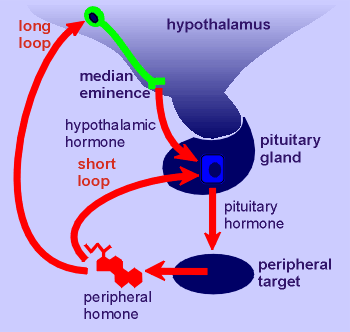 This regulation begins in the hypothalamus where neurons
produce hormones which are released into the portal blood of the median eminence and
carried from there to the pituitary gland (hypophysis).
This regulation begins in the hypothalamus where neurons
produce hormones which are released into the portal blood of the median eminence and
carried from there to the pituitary gland (hypophysis). An important component in the mechanisms regulating the biosynthesis of sex steroid hormones, glucocorticoids and the hormone thyroxine is through feedback loops whereby these hydrophobic hormones feedback on the central mechanism involved in their regulation.
The biosynthesis of steroid hormones of the adrenal cortex and gonads as well as thyroxine from the thyroid gland are under control of hypothalamus-hypophyseal system (see table).
 This regulation begins in the hypothalamus where neurons
produce hormones which are released into the portal blood of the median eminence and
carried from there to the pituitary gland (hypophysis).
This regulation begins in the hypothalamus where neurons
produce hormones which are released into the portal blood of the median eminence and
carried from there to the pituitary gland (hypophysis).
In the pituitary gland these hormones stimulate the release hormones from target cells, thyrotropes, corticotropes or gonadotropes.
The hormones from these pituitary cells then stimulate the production of the steroid hormones or thyroxine in the peripheral target tissue.
 A characteristic of the
peripheral hormones is that they all are hydrophobic and thus have the brain as a
potential target (being hydrophobic they can cross the blood brain barrier).
A characteristic of the
peripheral hormones is that they all are hydrophobic and thus have the brain as a
potential target (being hydrophobic they can cross the blood brain barrier).
One of the central targets is the neurons which make the hypothalamic releasing hormones.
Thyroxine and glucocorticoid give an inhibition (thus a negative feedback loop) to the production and release of the releasing hormones TRH and CRH respectively.
This form of negative feedback is sometimes referred to as long-loop negative feedback.
This is to distinguish it from short-loop feedback whereby the peripheral hormones inhibit the production and/or release of the pituitary hormones.
Feedback by the sex steroid estrogen is very complex and can be positive or negative.
In fact it is the intaction of the positive an negative actions that is the driving force for the so-called oestrus cycle which is one of the major topics of the lecture series in this course.